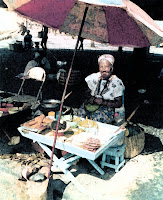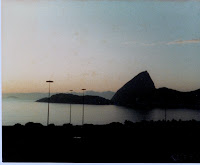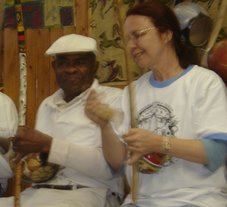
I feel like a Henry James character - I have a guilty conscience about exploiting people via the exchange rate, but everyone is out to exploit me! I bought a berimbau, two whistles, an agogo (cowbells) and a colimbré (?) for $10 at Cz$28 per dollar, and still somehow I feel I've been had. Oh well.
Yesterday, I did a quick tour - saw the Mercado Modelo, bought fitas (after bargaining down the price), bought stamps and discovered that the Portuguese word for envelope is "envelope" (pronounced "enveloppy").
I wandered the Pelourinho district - a rough place even in the daytime (and the capoeira schools open at night). Three malandros offered an exorbitant exchange rate (Cz$32 to the dollar) if I sold them $200. I thought better of it.
[Here's the whole story: Every time I arrived in the plaza facing the Lacerda Lift in the Upper City, I was greeted by a young boy - a different one every time - who showed me a very good exchange rate written on a bit of paper. It was tempting. If I exchanged the dollars I still had at those rates, I could have lived like a queen for the rest of my stay. I asked my hosts what they thought and, in typically Bahian fashion, they shrugged and said "give it a try."
Still suspicious - thinking that if it was too good to be true it was probably false - I decided to test it out. The young kid of the day took me to Cantina da Lua - then an infamous dive and now a popular watering spot for tourists - and the three malandros sat down at a table with me to negotiate.
"We'll give you that rate for $200," said the head honcho.
"But I only have $20 on me," I replied.
When they saw that I was serious and wasn't going to offer them what they wanted, they all left except for one bright spark, who said "Give me the $20 and I'll go and fetch your money."
I said, "No, thanks, I'll wait for you to bring it here, then we can swap."
He shrugged and walked away.
It became clear that the scam was either to give unsuspecting tourists a wad of useless bills - because of rampant inflation at the time, valuable notes soon became worthless - or simply to take off with their money and disappear in the labyrinth that was Pelourinho.]
I took the Circular Bus to Campo Grande, the hub of Carnaval. Not much going on there during the week. My main accomplishment was getting 8 letters ready to mail. I sent fitas to everyone who would know what they are. I still have 17 people on my list. Cards and enveloppies are cheap, but stamps are a killer!
Today, I paid for the berimbau, etc., to pick up later, took a bus to Campo Grande, walked to the federal university's dance department, then walked along the precarious "sidewalk" of the beltway along the bay back to the Mercado Modelo [little did I know that this was and is one of the most dangerous parts of the city].
For lunch, I had cocoa juice mixed with orange juice and acarajé (again). The man who sold me the berimbau has taken a fancy to me - he even offered to let me stay at his mother's house till March! I don't know...



